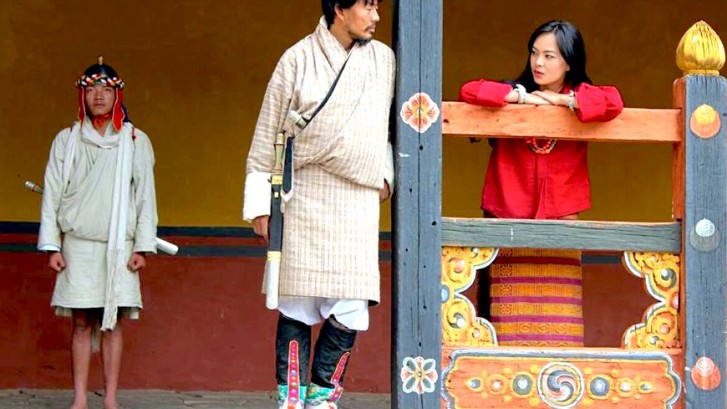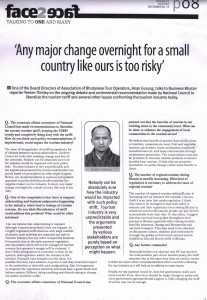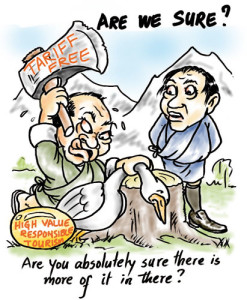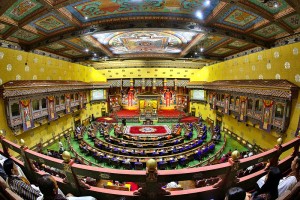BHUTAN IN THE RISK OF LOOSING IT’S UNIQUE TOURISM POLICY
DON’T KILL THE GOOSE THAT LAYS THE GOLDEN EGGS
This is in response to the National Council’s recent recommendation on the liberalization of the daily tourism tariff.
The fact that there has been a steady increase in the number of new tour operators over the years, from a mere single digit in the 1970’s to about 1,700 hundred tour operators today, shows the present tourism policy was never confined to a select few.
Four years ago, I along with my six friends was out of job and exploring business ideas. The tourism policy and regulations were so conducive and protective that we all went into the tourism business. Thanks to the “high value low impact policy” it not only benefited the country but us too, being new in the market with no capital and only with some researched data in hand. The tourism industry was never confined to few but was open for all interested and each had their share of the pie depending on their hard work and quality of services delivered.
Now, how certain are we and from which angle does one get the assurance that if the daily tourism tariff is liberalized, the number of tourists visiting Bhutan will fairly be distributed amongst all the 1,700 tour operators? If this is not a personal assumption then there must be a mathematical solution whereby the liberalization of the daily tariff will equate to fair distribution of tourist to all concerned parties.
And, even if this holistic fabulous approach succeeds, are we encouraging a healthy competition and creating a level playing field among the players in the market? Or will this make the well established few tour companies with their own fleet of cars and hotels all over the places take the edge over the middle and small/new tour companies by offering the lowest price to the tourists? With the price into play and a consumer’s basic instinct to go for the lowest price, will this not knock out the middle and small/new tour companies off the tourism industry for good?
The more danger also lies in the background, which is even bleaker. Let us not forget our country getting run down by mass tourism with negative impact on the environment and community. Let us also consider the frightening impact it will have on our fragile youth as a result of cheap tourism and influx of poor quality tourists. Can we afford to turn a blind eye on the negative impacts of this liberalization?
Similar concerns were shared by all of the people I met and they also voiced the same unease. While I appreciate the National Council’s Economic Affairs Committee and their initiative for equitable socio-economic development, such recommendations also makes me doubt a little on whether there are any vested interests based on the select people and those from the tourism industry who called and applauded the recommendations.
Let us not murder this highly prized tourism industry (even widely appreciated in the international market for its noble tourism policy) as a result of some good orators, just because they can make valid opinions to an apparently ‘doing very well, no change required’ situation. If we are to make any changes in the current policy, let us be practical and be fully convinced to apply for change in the larger interest of the country.
It is interesting to note that some of our learned and Honorable Members of the National Council are expecting to bear fruits after cutting down the tree from the roots. “When prices become competitive, tour operators will come up with many tourism products from various parts of the country, which would actually benefit areas not touched until now,” Zhemgang Councilor was quoted saying
If the prices were to play, I would rather focus on areas and products with less time and resources to bring down the cost. I would rather promote Thimphu and Paro only as there are many choices in hotels, especially regarding room rates, well developed infrastructure and avoid additional transportation cost. If I was to promote far flung areas like Lhuentshi and Zhemgang then the overall cost of the tour package will be high, whereas I can easily convince the tourists to spend their (already) limited time in Thimphu, Paro and the nearby regions.
Tourist actually come to experience the unique culture of Bhutan and I can easily promote remote villages of Thimphu, Paro, Haa, Punakha and Wangdue valleys as they also have a lot to offer in terms of traditional authentic Bhutan experience and its not as necessary to take them to the east or central parts of the country.
Having said that, until now, the price of the tour package (daily tariff) never interfered in the itineraries I designed for my guests. Depending on their time, my guests could visit all the places both near, far and remote, because I want my guests to experience and explore as many places as possible within their time frame since the prevailing daily tariff is more than enough to cover all of their expenses and more.
Now, if the liberalization of the daily tourism tariff comes through I may as well prepare myself for the oncoming war with other tour operators solely based on the prices.
However, on the other hand, if the liberalization does not come through and if we don’t need to compete with the prices, we can then think of competing in other ways. One main focus can be in improving and diversification of various tourism products to attract and uphold Bhutan as a unique holiday destination.
I have been in the industry for the last four years. Since the daily tariff is fixed and regulated, my focus was on quality improvement and product diversification. Also since tourists are aware of this fixed daily tariff, there is no time lost in negotiating and haggling the costs! Instead we focus on creating a unique and quality experience worth the dollars.
I earnestly request all members of the Parliament to consider all concerns and the impact of such a recommendation, so that, such irreversible policy change will not kill the goose that lays the golden eggs.
Contributed by Sonam Dendup
BHUTAN NEEDS A COMPREHENSIVE TOURISM POLICY
After a one-year long review of the tourism industry, the National Council’s Economic Affairs Committee called for an urgent need of a comprehensive tourism policy and recommended a revision of the tourism tariff.
These were among the seven recommendations deliberated in the House yesterday.
“Considering the significance of the sector and the exponential rise in tourist arrivals, it has become imperative to have a comprehensive policy to guide the sector including unregulated regional tourists,” the committee’s chairperson Pema Tenzin said.
Without a policy, the Bhutan Tourism Rules, schedules of tariff for international tourists 1995 and the Trekking in Bhutan Rules and Regulations 1996 regulate the sector today.
The committee also recommended to enforce a proper pricing mechanism.
Dagana Councillor Sonam Dorji said the tariffs were revised in January 2012 from USD 200 to 250 for peak season and from USD 165 to 200 for lean seasons and a royalty of USD 65 to the government.
“Given the competitiveness of the sector, the existence of multiple players in a fixed tariff system has led to predatory pricing among operators,” he said. “Hence the issue of undercutting which could undermine the core value proposition of Bhutan’s tourism which is to ensure high value and low impact.”
“While retaining the royalty component, the government could drop the tariff itself to ensure that the tourism system maximizes benefits and opportunities and minimizes tourism leakages,” Sonam Dorji said.
Other members also said that the fixed tariff caused wrong marketing and awareness with the misunderstanding of all-inclusive nature of tariff.Since its inception in 1974, the country has followed a policy of ‘high value, low volume’ tourism, which kept it well regulated.
In 2009, the government announced the policy of ‘high value, low impact’ as part of its Accelerating Bhutan’s Socio-Economic Development initiative and set a target of 100,000 tourists a year by 2012 opening the country to regional tourists as well.
Until 2008, only 27,000 dollar paying tourists and 12,000 regional tourists visited the country. The number rose in 2014 to 133,480 tourists, the majority of which were regional tourists, 68,000. The government has pledged to increase tourist arrival to more than 200,000 by the end of this Plan.
The committee recommended focusing on quality and not just quantity.
“We must be mindful of the carrying capacity of our natural and cultural environment to deal with an influx of tourists that is about one third of our own population,” eminent member and a committee member Dasho Tashi Wangyel said.
He said the government should conduct a research to know the maximum carrying capacity of the tourism activities- both tangible and intangible.
A situational analysis found that benefits from tourism are not spread equally across the country. Although the government pledged to make 20 percent of tourists visit eastern dzongkhags, as of 2014 only 3.6 percent had arrived there.
The committee called the government to spread the benefits to these dzongkhags through more investment in infrastructure and transport sectors, strengthen coordination among agencies, involving local leaders in identifying local tourism products and diversify tourism products.
Pemagatshel Councillor Jigme Rinzin said for instance, Pemagatshel could offer trekking around the place with the route connecting historic places such as temples in the dzongkhag.
Samdrupjongkhar Councillor Jigme Wangchuk said the southern dzongkhags such as Sarpang, Samtse and Samdrupjongkhar should be opened for tourists.
“The security threats have ended in 2003, and these places have ready entry and exits points which would serve as an advantage,” he said.
Without a regulation, regional tourists the review report states were involved in unfortunate incidents including deaths, and other avoidable problems. The committee called for measures to improve travel and experience for regional tourists and avert problems.
The review also asked the government to develop tourism and hospitality professionals by providing more scholarships to fill the shortage of professionals in the industry such as professional guides and qualified employees.
It also found the need for the government to work on a system and procedures for taxation and reporting of earnings from the sector.
National Council will continue its deliberations on the industry today.
SOURCE: KUENSEL (Tshering Palden)

Bhutan Tourism policy under review
The policy will also cover regional tourists that is increasing by the day
To address emerging challenges and trends in the tourism industry, a team from the World Bank is reviewing Bhutan’s tourism policy.
Tourism Council of Bhutan officials said a team of tourism specialists visited the country early this month to get an understanding of the tourism industry.
With tourism industry across the globe witnessing new trends and challenges, council officials said the World Bank’s technical team would address similar issues in Bhutan’s tourism industry.
“The team would study the current tourism policy and carry out desk research to recommend appropriate measures and consider the view of the stakeholders for the benefit of the tourism industry,” a council official said.
As part of the review, council officials said the team would look at all tourism related policies and regulations. In doing so, the team is expected to come up with a policy to govern regional tourists as well.
The review comes at a time when the National Council’s economic affairs committee is also reviewing the tourism policy to address issues of seasonality, equal distribution and spread of income and benefits. Also, the Association of Bhutanese Tour Operators as well as the Hotels and Restaurants Association of Bhutan are also reviewing the policy.
According to the council, tourism is a vibrant business with high potential for growth and further development. The government strongly adheres to a policy of ‘high value, low impact’ tourism, which serves the purpose of creating an image of exclusivity and high yield for Bhutan.
The principle of “high value, low volume” has been the overall tourism policy since 1974, which later changed to “high value, low impact” in 2008.
Although an important sector, the industry is not governed by an Act or a proper policy or a master plan even today. The tourism bill that was drafted a few years ago still remains to be discussed.
Council officials, however, said that the tourism strategy, 2013 and tourism master plans 1986 and 2005 do exist.
A council official said that most stakeholders take the master plan as an annual report. “A master plan is a roadmap and not an annual report and as for the strategy, we’ve activities under the Plan period,” he said.
However, most of the tourism stakeholders like hotels, guides and tour operators are not aware of the master plan and those who are argue that it is not implemented accordingly, indicating communication gaps between the stakeholders and the council.
For instance, tour operators said that as per the tourism master plan 2005, the tariff system was supposed to be different and the other stakeholders were supposed to lead the marketing while the council was to do the overall promotion of Bhutan as a destination.
However, stakeholders said that many of the recommendations of the master plan have not materialised even today.
Today, there are more than 1,300 tour operators that market the same product or package for both cultural and trekking tourists.
In 2013, the council submitted the draft national tourism policy 2012 to the Gross National Happiness Commission (GNHC) for screening. However, the policy did not come through and was never put up again.
The tourism policy protocol report submitted to the GNHC stated that the national tourism policy was developed in 2005. The policy was developed together with the tourism bill. The tourism policy was expected to guide all tourism activities, in line with the principle of high value, low impact principle.
However, tourism stakeholders welcome the council’s move to review the policy, which they said was long overdue.
The guides’ association and hoteliers say that the policy must ensure equal distribution of power and income within the industry. They said that in the existing system, it’s tour operators who make all the decisions and take the lion’s share of the minimum daily tariff.
Some suggested that there be a change in the existing principle of high value, low impact and that the minimum daily tariff of USD 200 and 250 be done away with. Others said that for tourism benefits to trickle down to the grassroots, there was a need for a structural change.
However, a majority of tour operators support the high value, low impact principle but point out that the industry is in a dire need of a vision and strategy. To address sustainable tourism, tour operators said a master plan or policy has become essential.
Since tourism activities were privatised in the ‘90s, tourism business started with 15 government-trained guides, 33 operators, a handicraft shop, and two government-owned hotels. Today, there are over 2,300 guides, 1,600 tour operators and 123 hotels in the country.
Contributed by: Kinga Dema (Kuensel)



